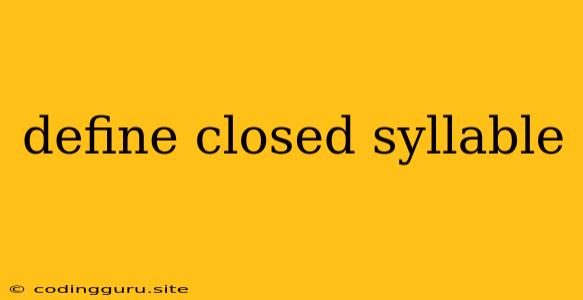What is a Closed Syllable?
In the world of phonetics and phonology, syllables are the building blocks of words. Each syllable typically consists of a vowel sound, which can be accompanied by one or more consonant sounds. A closed syllable is a type of syllable that ends with a consonant sound. This seemingly simple concept holds significant importance in understanding pronunciation and word structure, especially in English.
The Basics: Recognizing a Closed Syllable
To grasp the concept of a closed syllable, let's break it down into its key characteristics:
- It ends with a consonant sound: The most crucial feature is that the syllable must finish with a consonant. This consonant sound can be any of the 24 consonant sounds in English, including single consonants like "t" or "s" or consonant blends like "bl" or "st."
- The vowel sound is short: A closed syllable usually contains a short vowel sound. This is because the consonant at the end prevents the vowel from being stretched out, as it often is in open syllables. For example, the vowel sound in the word "cat" is short, while the vowel sound in the word "go" is long.
Examples of Closed Syllables
Here are some simple examples of closed syllables:
- "cat" - ends with the consonant sound "t"
- "dog" - ends with the consonant sound "g"
- "desk" - ends with the consonant sound "k"
- "plum" - ends with the consonant sound "m"
- "stop" - ends with the consonant sound "p"
Why Closed Syllables Matter
Understanding closed syllables is essential for several reasons:
- Pronunciation: Knowing how to identify closed syllables helps you pronounce words correctly. In a closed syllable, the vowel sound is typically short.
- Spelling: Closed syllables often follow specific spelling patterns. For instance, the short vowel sound in a closed syllable is often represented by a single vowel letter.
- Word Structure: Closed syllables play a crucial role in understanding word structure. They help us to break down words into their constituent parts, which can be helpful for reading and writing.
The Importance of Context
While the general rule states that closed syllables have short vowel sounds, context can sometimes influence this rule. For example, consider the word "name." Here, the "e" at the end of the word acts as a silent letter, and the "a" has a long vowel sound, even though the syllable ends with a consonant. This illustrates that understanding the overall word and its context is necessary for correct pronunciation.
Closed Syllables in Multisyllabic Words
The concept of closed syllables can also be applied to multisyllabic words. Consider the word "elephant." This word has three syllables: "el", "e", and "phant." The first syllable "el" is closed because it ends with the consonant sound "l". The second syllable "e" is also closed because it ends with the consonant sound "e". The final syllable "phant" is open because it ends with a vowel sound.
Closed Syllable Patterns
In English, there are several common spelling patterns associated with closed syllables:
- VC (vowel + consonant) - This pattern often represents a short vowel sound, as in "cat" or "dog."
- VCC (vowel + consonant + consonant) - This pattern also typically represents a short vowel sound, as in "stop" or "truck."
- Vowel digraph followed by a consonant - This pattern also often represents a short vowel sound, as in "rain" or "float."
Understanding the Impact on Reading
Understanding closed syllables is vital for fluent reading. By recognizing the typical spelling patterns of closed syllables, readers can more easily decipher the pronunciation of unfamiliar words. This knowledge can greatly enhance reading speed and comprehension.
Conclusion
Closed syllables are a fundamental concept in phonetics and phonology. They are a key element in understanding the structure and pronunciation of words, especially in English. By learning to identify closed syllables and their typical spelling patterns, you can improve your reading and spelling skills.
